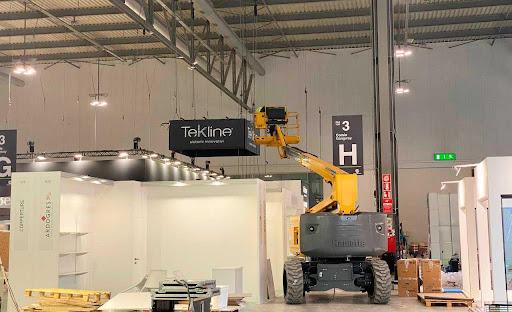The choice of materials and technologies when designing exhibition stands is the most critical aspect that largely determines the success and attractiveness of the entire presentation. Exhibitions serve as a platform for companies and organizations to showcase their products, services, and ideas to a broad audience. Choosing suitable materials and technology plays a crucial role in attracting attention, conveying brand messages, and creating a memorable experience for visitors.
The aesthetic appeal of the booth influences brand image. The materials from which an exhibition stand builder makes an exhibition stand determine its visual appeal and aesthetic qualities.
The technologies integrated into the booth are also part of the visual design of the booth. They also allow for increased interactivity and visitor engagement. The choice of materials is critical to the strength and durability of an exhibit.
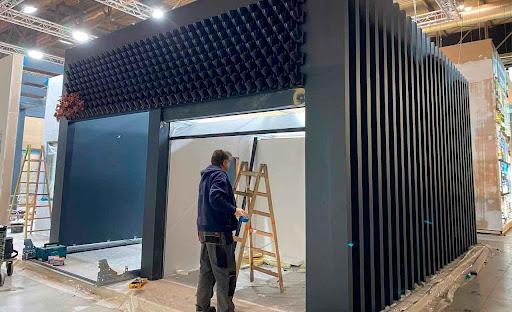
In addition, with the increasing focus on environmental sustainability, the choice of materials is being scrutinized by show organizers and visitors. Choosing environmentally friendly and recyclable materials demonstrates a commitment to sustainability and can enhance a brand’s reputation.
Most importantly, the choice of materials and technologies affects the overall cost of designing and building an exhibit. It is essential to strike a balance between quality and cost-effectiveness.
A thoughtful combination of visually appealing materials, interactive technologies, durability, adaptability, and sustainability contributes to a compelling and memorable exhibit that ultimately helps companies achieve their goals and leave a lasting impression on visitors.
Table of Contents
Development of Materials and Technologies
Over time, preferences in materials and construction techniques for trade show booths have evolved significantly, reflecting changes in design trends, technological advances, and changing environmental awareness.
Traditional materials for exhibit design and construction are wood and fabric.
Traditional exhibit booths were often constructed of wood and plywood. While these materials are durable, they can be heavy and limit the flexibility of modern design.
In addition, fabric and vinyl were often used to create banners and signs. While these materials are versatile, they lack the durability and visual impact of modern alternatives.
Traditional booths have historically been static displays with limited interactivity, relying on printed materials and physical product displays. Technology integration was minimal, using basic lighting and audiovisual equipment. Interactive and digital displays were less common due to technological limitations and cost.
A decade ago, environmental considerations did not play a major role in material selection. Sustainability and recallability were often ignored in favor of more traditional options.
Modern and Environmental Materials
Modern technology has expanded the ability to use materials and equipment to create more complex and unusual booth designs.
Modern trade show booths often use aluminum and lightweight composite materials. These materials are strong, durable, and adaptable to modular designs. The move to lightweight structures allows for easier assembly and adaptability to different exhibit spaces. Modular components can often be reused, reducing both cost and environmental impact.
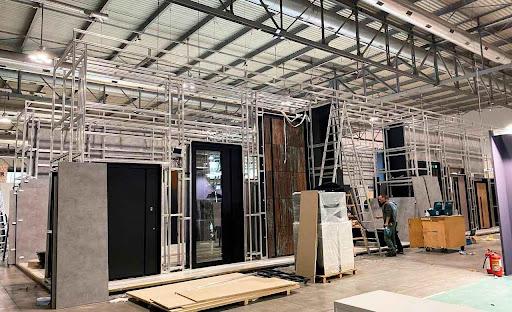
Modern fabrics with color printing capabilities are being used for branding and signage. These fabrics are often lighter, more durable, and can be recycled at a later date.
Modern booths can be partially or fully prefabricated on site, reducing construction time and minimizing disruption.
Interactive displays, touch screens, augmented reality, and virtual reality have become commonplace in exhibit design. These technologies increase visitor engagement and create a more immersive experience.
LED screens and digital signage are widely used to create dynamic and easily updated displays that provide flexibility in communicating information.
Environmental considerations:
Most importantly, there is a growing emphasis on sustainability and the use of recycled and recyclable materials. Many exhibit designers and clients prefer green options to reduce the environmental impact of events. The integration of energy-efficient lighting and technology is becoming more common, in line with broader efforts to reduce the carbon footprint of trade show events.
While advanced materials and technologies may have a higher initial cost, their long-term value is often more significant due to factors such as reusability, adaptability, and reduced maintenance costs.
Efficiency, adaptability, and creating an engaging visitor experience are at the forefront of today’s approaches, demonstrating a more dynamic and forward-thinking approach than the traditional methods that have been prevalent in the past.
Modern materials for exhibition stand design
PVC is a durable material that resists wear and tear, making it suitable for long-term use in exhibition booths.
It is versatile and can be easily molded into various shapes, allowing for creative and customized designs. It is generally more economical than some other materials, making it a favorable option for exhibit construction.
PVC is often used for banners and signage because of its lightweight and print-friendly surface. PVC tubes and panels can be used as structural elements of modular exhibit booths. The PVC panels can be used as backdrops or wall coverings, providing a smooth and polished look.
Another popular modern material is acrylic. Acrylic is highly clear and transparent, allowing for sleek and modern exhibit elements.
Acrylic is lighter than glass, making it easier to carry and transport when organizing exhibitions. It is weather-resistant, which allows it to be used both indoors and outdoors. This material is often used to create transparent displays to showcase goods, making them visually appealing.
Because of its transparency and ability to be cut into precise shapes, acrylic is an excellent material for logos and branding elements.
It can also be used to create lighting elements such as signage and backlit displays.
Another modern, convenient material is recyclable plastic. Recyclable plastics contribute to the sustainability of the exhibition industry by reducing the environmental impact of booth construction. Using recycled plastics helps conserve natural resources and minimizes the need for virgin raw materials. Some recycled plastics can be part of closed-loop recycling systems where materials are reused multiple times, further reducing waste.
These plastics can be used to make a wide variety of exhibit components, including panels, furniture, and decorative elements. Recycled plastic flooring options are also available, providing an environmentally friendly alternative to traditional flooring. Recycled plastics can be used in modular designs, allowing for easy disassembly and reuse.
The use of PVC, acryli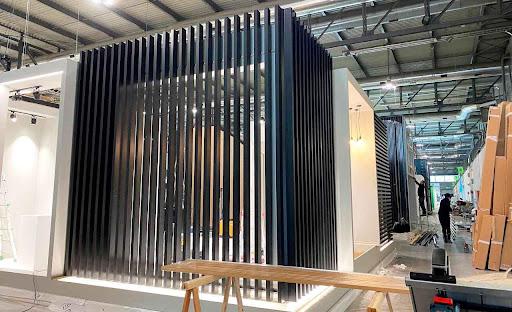 c, and recyclable plastics not only helps to create visually appealing exhibition stands but also contributes to sustainability goals, which is in line with the growing focus on environmental considerations in the event industry.
c, and recyclable plastics not only helps to create visually appealing exhibition stands but also contributes to sustainability goals, which is in line with the growing focus on environmental considerations in the event industry.
Technologies in Exhibition Stand Design
Technology in exhibit design has become an integral part of creating an engaging and memorable experience. Touch screens, interactive kiosks, and augmented reality (AR) enhance visitor engagement by allowing them to interact with content and products. LED displays, video walls, and dynamic digital signage provide dynamic and easily updated content that attracts attention and effectively communicates information. Virtual Reality (VR) and Augmented Reality (AR): VR and AR technologies provide an immersive experience that allows visitors to explore products or environments in a virtual space.
Radio Frequency Identification (RFID) and Near-Field Communication (NFC) enable personalized interactions, track visitor engagement, and streamline information sharing. Collecting data on visitor behavior and interactions helps exhibitors analyze the effectiveness of their booths and make informed decisions for future events. Projection mapping transforms static surfaces into dynamic displays, creating visually stunning and attention-grabbing presentations.
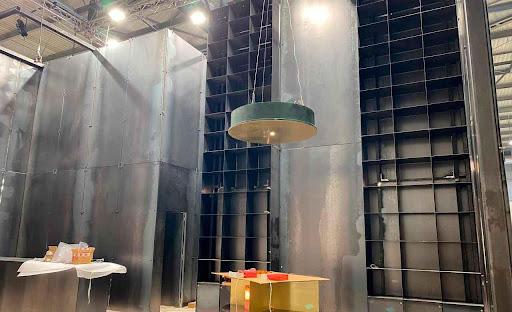
Custom mobile apps enhance the visitor experience by providing event information, interactive maps, and real-time updates, driving visitor engagement before, during, and after the show. Integration with social media platforms allows for real-time information sharing, extending the reach and impact of the show beyond the physical space.
The availability of wireless charging stations allows you to meet the practical needs of attendees while engaging them with booth content. Artificial intelligence-powered chatbots can answer visitor questions, provide information, and offer personalized experiences to enhance customer interactions.
As you can see, incorporating these technologies into booth design increases interactivity, improves brand awareness, and helps exhibitors stand out in a competitive landscape. It also meets the evolving expectations of tech-savvy attendees and contributes to the overall success of an exhibit.
Interactive Technologies
Of all the modern technologies being used in exhibitions, we find the use of VR and AR to be the most interesting.
AR overlays digital content onto the natural environment, enhancing the user experience by adding information, graphics, or interactive elements. This allows users to interact with virtual elements in real-time, creating an immersive and engaging experience.
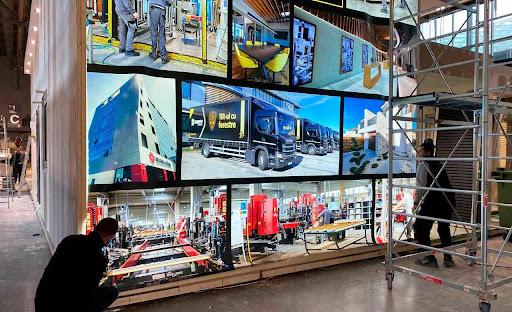
AR systems can understand physical space, allowing virtual objects to interact accurately with the real world.
This technology enhances visualization by providing additional context or data related to physical objects, making it valuable for product demonstrations or educational purposes.
For example, AR can be used to display 3D models of products when users scan a physical object, allowing them to see details, features, and customization options.
Printed brochures or posters can be brought to life with AR, providing additional information, video, or interactive elements when viewed on a mobile device.
AR can be used in training simulations, overlaying educational information on real-world scenarios for hands-on learning. This is particularly relevant for exhibitions with similar themes.
VR, on the other hand, creates a fully immersive, computer-generated environment. Users can explore and interact with it directly.
VR provides a 360-degree field of view, allowing users to look in any direction and feel surrounded by the virtual environment. This technology allows users to engage in simulated interactions, making it suitable for learning, gaming, and virtual walks.
For example, VR can be used to create virtual tours of real estate, event venues, or tourist destinations, providing an immersive experience for potential customers or visitors.
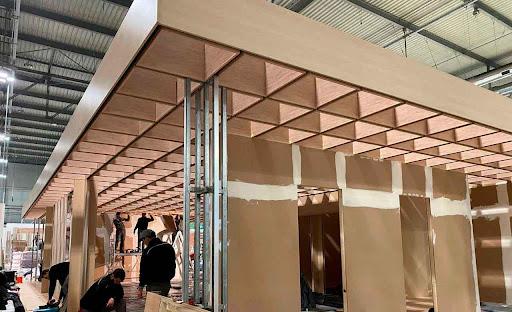
The technology effectively creates realistic training simulations, especially in fields such as healthcare, aviation, and emergency response. VR gaming provides an unparalleled level of immersion, allowing players to feel as if they are inside the game environment.
VR allows architects and designers to explore virtual representations of buildings, interiors, and landscapes before they are built. It can be used at trade shows on specialized topics to showcase solutions.
AR and VR have unique capabilities, and their applications spread across industries from entertainment and education to healthcare and business. Their ability to enhance the user experience and provide innovative solutions makes them powerful tools for engagement and interaction in various contexts, especially at trade shows.
Technologies for Personalization
In addition to visually engaging trade show attendees with advanced technology, you can create a personalized experience for them to interact with your brand.
- Engage by providing access to information.
Placing interactive screens as information kiosks allows visitors to access detailed information about products, services, or the company itself. Touch screens provide intuitive navigation that enhances the visitor experience.
Interactive screens can act as virtual product catalogs, displaying features, specifications, and multimedia content. Users can easily browse the products on offer, increasing engagement.
2- Interactive presentations.
Replace traditional printed materials with interactive presentations on screens. Visitors can interact with content, zoom in on details, and explore multimedia elements for a more immersive experience.
Interactive screens allow users to customize the content they see based on their interests. This personalization increases engagement by providing relevant information.
- Gamification.
Interactive games on screens add an element of fun to the communication process. Gamification can be used to educate visitors about products, services, or brand values while entertaining them.
Engage visitors with interactive quizzes or surveys displayed on screens. This provides valuable feedback and encourages active participation.
- RFID (radio frequency identification).
Visitors receive RFID badges that store their preferences and information. As visitors interact with different elements of the exhibit, RFID technology can deliver personalized content based on their interests.
RFID can be integrated into your booth tours. As visitors move around, RFID-enabled devices can deliver relevant content or information about specific exhibits or products.
RFID allows visitors to interact seamlessly with different stations. For example, touching a badge at a station can trigger a demonstration, video, or detailed product information.
RFID badges can give visitors instant access to resources such as brochures, technical descriptions, or contact information. With a simple tap, relevant materials can be sent directly to e-mail.
This technology can provide valuable data about visitor interactions, including popular exhibits, dwell time, and engagement levels. The resulting data can be analyzed to understand visitor behavior and preferences.
Trends and Innovations
Exhibition stand design is a dynamic field that is constantly evolving with new trends and innovations. It is moving away from traditional stand design to create unique and eye-catching designs that stand out on the exhibition floor.
For example, using sustainable and recyclable materials in booth design demonstrates a commitment to environmental responsibility. Using living walls or greenery in the booth to create a visually appealing and environmentally friendly atmosphere. Integrating augmented reality, including virtual reality (VR) and augmented reality (AR), creates an interactive experience for visitors.
Combining physical and virtual elements to create a seamless experience for both in-person and remote attendees.
By following these trends and incorporating innovative ideas, exhibitors can create booths that attract attention, encourage engagement, and leave a lasting impression on attendees.
The Future of Exhibition Booths
A number of innovative materials and technologies have the potential to revolutionize exhibit design. These advances enhance visual appeal and contribute to sustainability, interactivity, and the overall visitor experience. The future is already impacting the exhibition industry. We consider the most technologically advanced materials that will be used in the future to create unparalleled booth design.
Graphene
A single layer of carbon atoms arranged in a hexagonal lattice, graphene is known for its exceptional strength, flexibility, and electrical conductivity. It can be incorporated into booth materials to create lightweight and strong structures. Its electrical conductivity also opens up opportunities to create interactive elements and smart surfaces.
Biodegradable and Recyclable Materials:
Materials that are biodegradable or easily recyclable, reduce environmental impact. The use of environmentally friendly materials is in line with the growing focus on sustainability. Biodegradable plastics, recyclable metals, and other sustainable materials help reduce the environmental footprint of exhibit booths.
Responsive fabrics:
Fabrics are equipped with intelligent technologies that can respond to environmental conditions or user interaction. Responsive fabrics can be used to create dynamic and interactive displays that change color, pattern, or texture based on visitor interaction. They add sophistication and adaptability to exhibit designs.
3D-printed structures:
Use 3D printing technology to create complex and customizable designs. These components allow for highly detailed and unique designs. This technology provides manufacturing efficiency customization and reduces material waste for better resource management.
Self-repairing materials
Materials that have the ability to heal themselves after damage. Self-repairing materials can increase the longevity of trade show booths, reducing maintenance requirements and creating more durable structures.
Transparent Solar Panels
Transparent solar panels that allow light to pass through. Incorporating transparent solar panels into booth design can help create sustainable energy solutions by capturing sunlight and not obstructing views. This technology aligns with the push for renewable energy in the exhibit industry.
Flexible display technology
Lightweight, flexible displays that can be bent or flexed. They enable the creation of curved and dynamic screen installations that provide a visually immersive experience. These displays can be seamlessly integrated into various design elements.
Kinetic Architecture
Dynamic architectural elements that can move or change shape. Kinetic architecture makes exhibition stands dynamic and interactive. Moving walls, adjustable structures, or shape-shifting elements can draw attention and create memorable experiences.
Intelligent glass
Glass that can change its transparency or display digital content.
Smart glass can be used for interactive displays, provide privacy when needed, and become transparent surfaces for presentations or product demonstrations.
Nanomaterials
Materials created at the nanoscale that have unique properties and characteristics. Nanomaterials can be incorporated into various components to enhance strength, electrical conductivity, and other specific properties.
All of this opens up new possibilities for creating modern and highly effective exhibit structures. The integration of these innovative materials and technologies not only improves the aesthetics of booths but also contributes to sustainability, interactivity, and the overall development of the exhibition process.
Ecological approach
The exhibit construction industry is experiencing a noticeable shift toward environmental sustainability and sustainable development. This trend is driven by growing environmental awareness, increasing corporate responsibility, and demand for environmentally friendly practices. Key environmental trends and sustainability initiatives in the exhibit industry:
- The use of environmentally friendly materials.
- The use of modular and reusable designs.
- The use of energy-efficient technologies.
- Waste reduction and recycling.
- Certification and standards compliance.
- Carbon offsetting and foot printing.
- Educational initiatives.
- Integration of green technologies.
In summary, the exhibit construction industry is undergoing a transformation toward environmental sustainability and sustainable development. The trends discussed demonstrate a collective effort to reduce the industry’s environmental impact, use resources responsibly, and create a more sustainable future for exhibitions and events. As these trends evolve, the industry will likely see innovations and advancements in environmental sustainability.
The future of exhibit booths relies heavily on continued innovation in materials and technologies. By embracing sustainable practices, incorporating cutting-edge materials, and leveraging technological advancements, the exhibition industry can create booths that not only captivate audiences but also contribute to a more environmentally conscious and dynamic event landscape.

